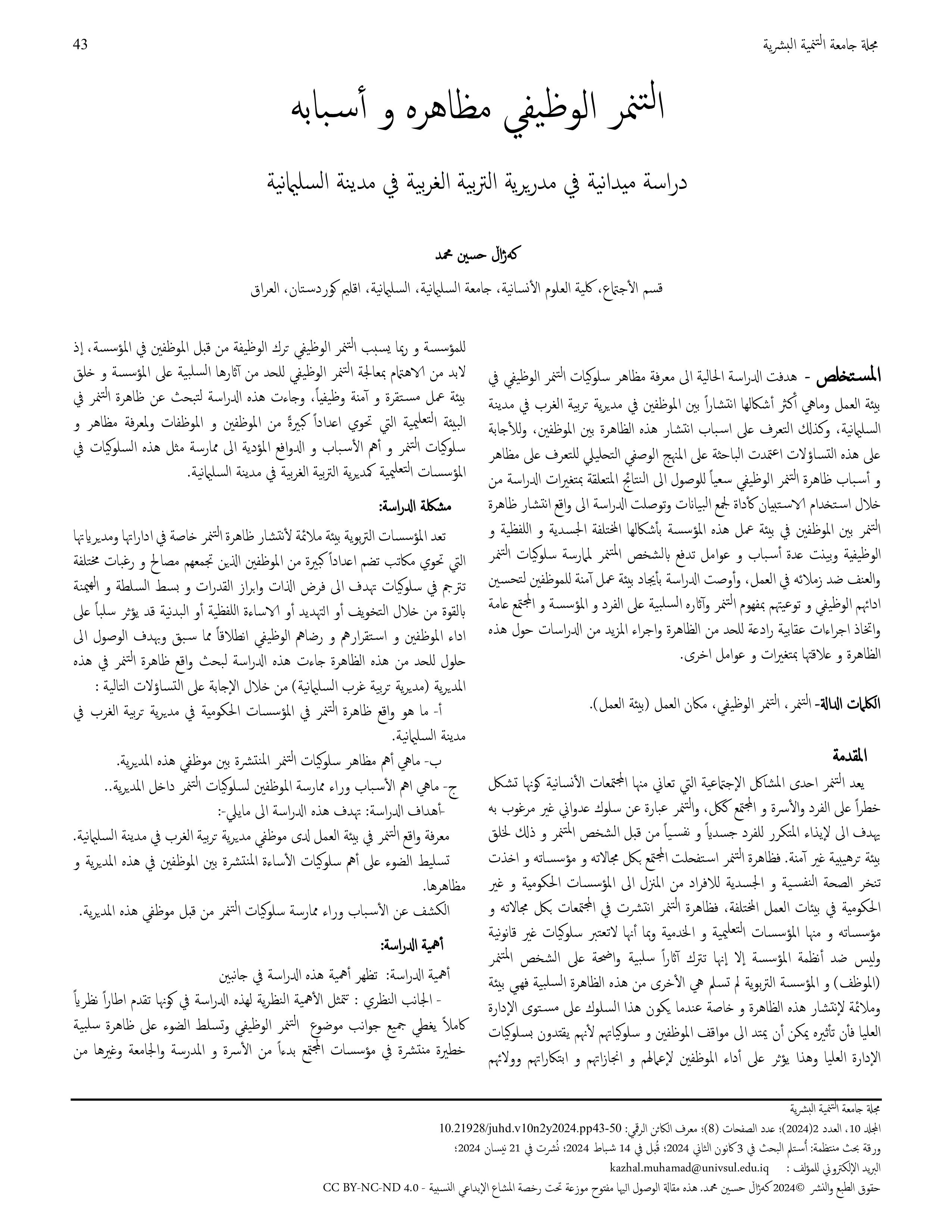Occupational bullying, its manifestations and causes
A field study in the Western Education Directorate in the city of Sulaymaniyah
DOI:
https://doi.org/10.21928/juhd.v10n2y2024.pp43-50Keywords:
Bullying, Workplace bullying, Workplace (Workplace environment)Abstract
The current study aims to identify the characteristics of workplace bullying in the workplace and reveals most of the patterns of expression among employees in the Western Education Directorate in Sulaimani which is taken as research samples, Moreover, the identification of the causes of the distribution of this phenomenon among employees in education institution, this is response to these questions, and analysis this phenomena in institution, the researcher relied on the descriptive analytical approach to the identification of workplace bullying, and causes of the effort to reach the results related to the variables of the study through using of (scale questioner) to gather evidence and reach the actual publication of the study, it is showed that the workplace bullying which is existed among employees in this institution in its various physical, verbal and functional forms and between a number of reasons and factors encourages the Buller to practice bullying behaviors against colleges as conflict function in the workplace, through suggestion and recommendation the study aims to create a safe work environment for employees to improve their job performance and their understanding of harassment and its negative impact of bullying on individuals and groups ,although having punishment for Buller to decrease the phenomenon and further studies on this phenomenon and its relationship to other variables and factors.
References
أ- المصادر العربية:
(العملة، عرفان محمد) (2019)، التنمر المدرسي وعلاقته بالذكاء العاطفي الوجداني لدى عينة من طلبة المرحلة الاساسية في مدارس مديرية شمال الخليل، ماجستير، كلية الدراسات العليا، جامعة الخليل، فلسطين.
الباعردي، جيهان زورو سعدو، (2021)، سلوك التنمر الوظيفي و دوره في الولاء التنظيمي، مجلة جامعة دهوك، المجلد 24، العدد (2)، العلوم الأنسانية والأجتماعية.
النعيمي، صلاح عبدالقادر، عزيز، شعيب أحمد (2018)، تأثير التنمر الوظيفي في الألتزام التنظيمي، دراسة استطلاعية لآراء عينة العاملين في المديرية العامة لتربية بابل، مجلة تنمية الرافدين، العدد (111) المجلد (73).
جابر عبدالحميد هبة (2015)، فاعلية التدريب على المهارات الأجتماعية في خفض سلوك التنمر لدى ذوي صعوبات التعلم، المجلة المصرية للدراسات النفسية، 25 (86).
سارين، دمرجيان و آخرون (2018)، أثر استراتيجيات علاقات العمل على سلوكيات التنمر في مكان العمل: الدور المعدل لممارسات الأدارة بالتجوال: دراسة ميدانية في فنادق خمس نجوم عمان، رسالة ماجستير، جامعة الشرق الأوسط.
صالح، زينة علي، جياد، مها سالم، الأستقواء وعلاقته بالتشويهات المعرفية لدى المراهقين في المدارس الثانوية، مجلة كلية التربية الأساسية للعلوم التربوية والأنسانية، جامعة بابل،(43).
الصبحين، على موسى، القضاة، محمد فرحان، (2013)، سلوك التنمر عند الأطفال والمراهقين، الأصدار الأول، جامعة نايف العربية للعلوم الأمنية، الرياض.
الصرايرة، منى محمود،(2007)، الفروق في تقدير الذات والعلاقات الأسرية والأجتماعية والمزاج والقيادية والتحصيل الدراسي بين الطلبة المتنمرين وضحاياهم والحاديين في مرحلة المراهقة، أطروحة دكتورا، كلية الدراسات التربوية العليا، جامعة عمان العربية للدراسات، الأردن.
العزوني، هدى سليمان، (2020)، أثر التنمر الوظيفي على كفاءة أداء العنصر البشري في المؤسسات الإقتصادية، مجلة بحوث الشرق الأوسط، (57)، الجزء الثاني.
العطوي، عامر علي حسين و آخرون، (2017)، التقويض الأجتماعي ودوره في تفسير العلاقة بين الروابط السلبية و الأداء الوظيفي، مجلة المثنى للعلوم الأدارية والأقتصادية.
مهيدات، رزان علي، والزغبي، دلال محمد (2014)، سلوكيات التنمر التي يمارسها العاملون في المؤسسات الأكاديمية، دراسات سابقة في الأردن والعوامل المرتبطة بها، المجلة الدولية للأبحاث، الأمارات، ص32 – 35.
(محمد، ثناء هاشم، واقع ظاهرة التنمر الألكتروني لدى طلاب مرحلة الثانوية في محافظة الفيوم وسبل مواجهتها، مجلة جامعة الفيوم للعلوم التربوية والنفسية (12)، (2).
English references: -
American psychological Association, (2014); Diagnostic and Mental Disorders, Washington, Dc, London.
Einarsen, S., Hoel H., & Notelaers, G. (2009). Measuring exposure to bulling and harassment at work: Validity, factor Structure and psychometric properties of the Negative acts Questionnaire. Revised work & strees (1).
Fox, C. & Boulton, Hejs (2003), Evolution of the effectiveness of a Social Skills training programmed for victimes of Bulling Educational Research, 45(3).
Glline-D 2017), Interventions for prevention of bulling in the work place, Vikalpa, vol (1)3, No 2.
Gordon, Sherri, (2020), Reasons why people are Bulled at work, http://very well mind.com /reasons why work place bullies target people 460783.
Lopierre, Jozee et al. Elizabeth Holloway (rood), Toxic Environment, in J. Barling at alledks), Handbook of work Stress, Thousand Oaks, CAT sage.
Namies Gary, (2003), work place Bulling Escalated incivility, Ivey Business Journal, online, IVEY management services.
Nica, E., Hurjuis. A Stefan 1. G. (2016), The Releva Ace of the organization Environment in work place Bulling processes Journal of Self Governance and Management Economics, 4(2).
Olweus, D., 1993, Bulling at school. What we know and what we can do Oxford, Black Well.
Sandvik, Pamela Luxgen, sypher, B-D, (2000), work place Bulling (Causes & Consequences and corrections, International Journal of Engineering and Management. Research, verume (6) (3).
Wolke, D. Sarah, W, Stanford, K & Schalzs, (2022) Bulling and Victimization of primary Schools children in England and Germani prevalence and School Factors, British Journal of psychology, (92).

Downloads
Published
How to Cite
Issue
Section
License
Copyright (c) 2024 Kazhal Hussein Mohammed

This work is licensed under a Creative Commons Attribution-NonCommercial-NoDerivatives 4.0 International License.


